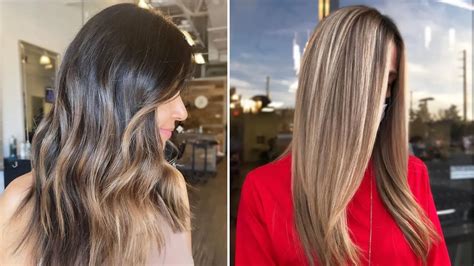When seeking to elevate your locks with a touch of radiance, two popular techniques emerge: balayage and highlights. While both methods infuse your hair with flattering hues, they differ significantly in their application, appearance, and maintenance. This comprehensive guide delves into the intricacies of each technique, empowering you to make an informed decision for your hair transformation.

Balayage: A Sun-Kissed Embrace
Balayage, a French term meaning “to sweep,” is a freehand painting technique that creates a natural-looking, sun-kissed effect. The colorist uses a brush to apply lightener to select strands, focusing on the ends and midshafts. This results in a seamless blend of highlights that gradually transition into the natural hair color, mimicking the subtle lightening caused by the sun.
Benefits of Balayage:
- Natural, Dimensional Look: Balayage preserves the integrity of your natural hair color, creating a subtle and sophisticated effect.
- Low Maintenance: The gradual blending of colors eliminates the need for frequent touch-ups, making balayage a low-maintenance option.
- Versatile for All Hair Types: Balayage can be customized to suit any hair texture or length, from fine to thick and from short to long.
Highlights: Striking and Precise
Highlights, on the other hand, involve a more precise application using foils or a cap to separate individual strands. The colorist applies lightener directly to these strands, creating a bolder and more contrasting effect. Highlights tend to be placed in specific areas, such as the crown or around the face, adding depth and dimension to the hair.
Benefits of Highlights:
- Dramatic Transformation: Highlights provide a more noticeable change in hair color than balayage, creating a bolder and more striking look.
- Customizable Placement: The controlled application allows hair stylists to place highlights strategically to enhance facial features or create specific styles.
- Suitable for Specific Concerns: Highlights can effectively cover gray hairs or add warmth to dull hair.
Deciding Between Balayage and Highlights
Consider Your Desired Look: Balayage is ideal for a natural, sun-kissed effect, while highlights offer a bolder transformation.
Maintenance Requirements: Balayage requires less maintenance than highlights due to its seamless blending.
Hair Texture: Balayage works well on all hair types, while highlights may be more suitable for thicker or coarser hair.
Cost and Time: Both techniques vary in cost and time depending on the number of highlights or the extent of balayage desired.
Table 1: Key Differences at a Glance
| Feature | Balayage | Highlights |
|---|---|---|
| Application | Freehand painting | Using foils or a cap |
| Effect | Natural, blended | Bold, contrasting |
| Maintenance | Low maintenance | Requires more touch-ups |
| Ideal for | All hair types | Thicker hair, gray coverage |
Frequently Asked Questions
Which technique causes less damage to hair?
Both techniques involve chemical processing, but balayage is generally considered less damaging as it avoids direct contact with the scalp and only affects select strands.
How long does each technique take?
The time required depends on the number of highlights or extent of balayage desired. Balayage typically takes longer than highlights.
Can I do balayage or highlights at home?
While DIY hair treatments are popular, it’s highly recommended to seek professional guidance for both balayage and highlights to ensure optimal results and minimize hair damage.
Motivations and Pain Points
- Motivation: Desire for a natural, low-maintenance color transformation.
-
Pain Point: Limited ability to create precise or dramatic color changes.
-
Motivation: Desire for a bolder, more noticeable color change.
- Pain Point: Frequent touch-ups required to maintain the desired effect.
Effective Strategies
For Balayage:
- Consult with an experienced hair stylist to determine the optimal color and placement.
- Use a sulfate-free shampoo and deep conditioner to maintain vibrancy and reduce fading.
- Trim split ends regularly to prevent breakage and enhance the seamless blend.
For Highlights:
- Choose a colorist who specializes in highlighting to ensure precision and minimal damage.
- Invest in a toner to neutralize any unwanted brassiness or warmth.
- Use a heat protectant spray before styling to shield hair from damage.
Conclusion
Balayage and highlights each offer unique advantages, allowing you to customize your hair color to suit your style and preferences. By understanding the distinct differences between the two techniques, you can make an informed decision that will elevate your hair’s radiance. Whether you crave a natural, sun-kissed effect or a bolder, more dramatic transformation, there’s a technique waiting to transform your locks.
